This past year, due to Covid, I wasn't able to be on site with a healthcare organization for 359 days. That's almost a full year, of course.
In the past three weeks, I've been fortunate to have the chance to visit four different vaccination sites:
- An indoor mass vaccination site at a campus sports center in San Diego
- A drive-thru parking lot site in San Diego
- A drive-thru at Dodger Stadium in Los Angeles
- An indoor mass vaccination site at a former Sears store in Frisco, Texas
They were all very upbeat and optimistic settings. The work being done at these sites is helping put the pandemic behind us. Vaccination can be life-changing for those who haven't been able to see their grandchildren for over a year.
People are grateful… and it reminds me of what I was told (almost 20 years ago) about my wedding day… it doesn't really matter if something goes wrong — because the end result is good. That's a good thing for a perfectionist to be reminded of.
That gratitude (that I feel and others felt) supersedes the analysis of “how much waste was there?” or “how Lean was that process?” That said, no process is perfect… and everybody involved is trying to serve their communities in a way that's pleasant and respectful of everybody's time. That motivation is clear and powerful.
Two of the sites I visited (the indoor sites, coincidentally) were set up with Lean or the Toyota Production System in mind. The two drive-thru sites… not as much. But, again, the end result is they're vaccinating thousands of people daily and that's a victory right there, end of story.
My intent at three of these visits was to observe and learn (with the ability to share, within some constraints). My intent at the one was… to get the vaccination myself. I'll give a more detailed breakdown of what I experienced and how the San Diego site was different in a few cases.
Getting Vaccinated at Dodger Stadium
My first two visits to Dodger Stadium over the past decade were for games, of course.
Here is a photo that I took while at a game in 2011… and we'll start to see fans back at the stadiums soon. Thanks for allowing me the memory of pre-Covid times.

OK, here's what I saw driving up to Dodger Stadium this time… signs pointing specifically to the vaccination parking lot.
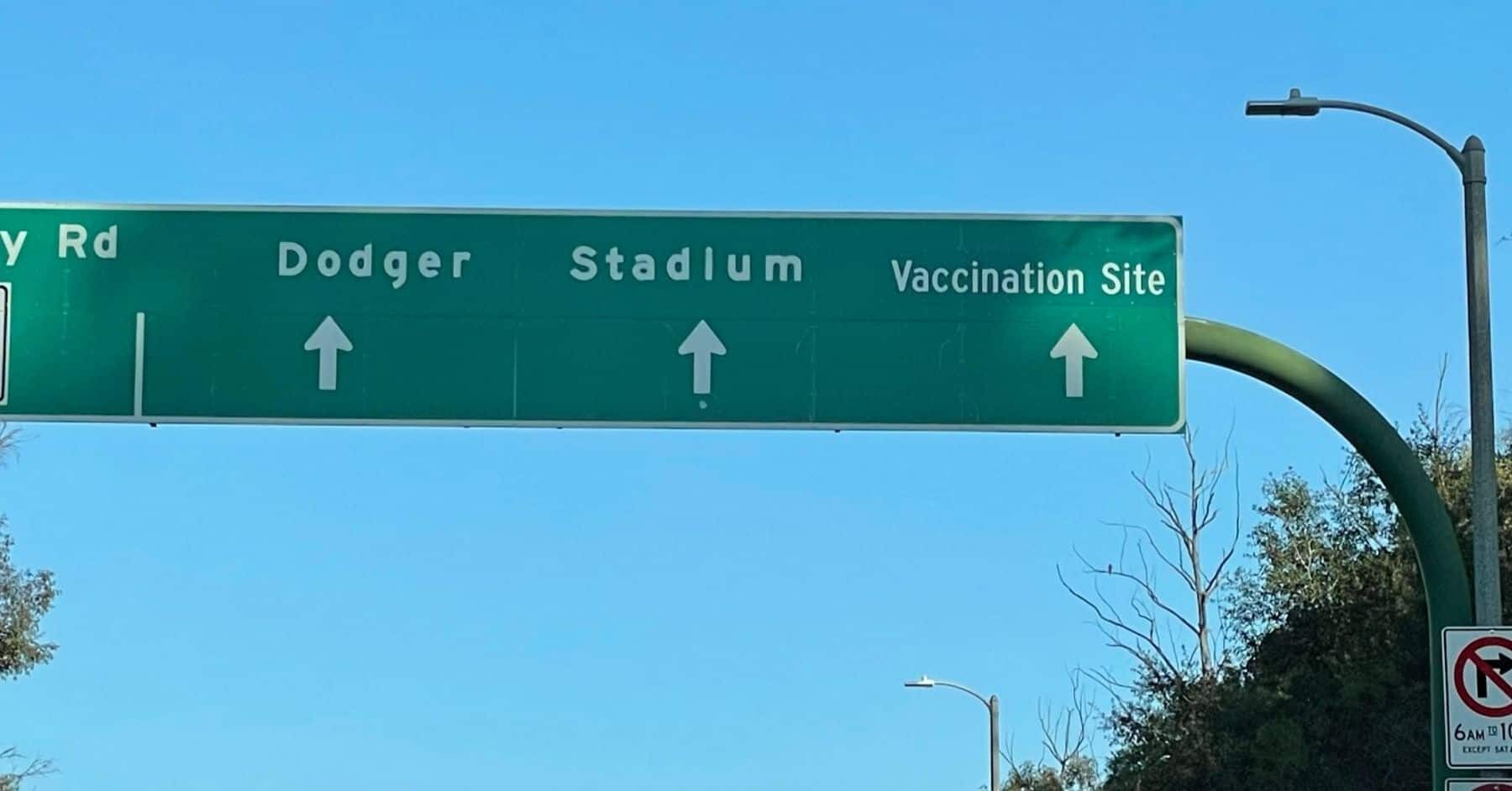
Finding an Appointment
Now, backing up a bit… getting scheduled. That Saturday morning, I read a LA Times story about how the “healthcare” tier had been expanded to include those in administrative, non-clinical areas. I have been in conversations about getting back on site with healthcare clients, and they would prefer to have visitors be vaccinated.
I went online and looked for appointments. In California, anyways, there were at least ten different sites or links to look at. I couldn't find appointments through some sites, including a local college or the pharmacy chains. I had heard about the Dodger Stadium site, so I tried that. I was surprised to see appointments available that very same day.
Opportunity for Improvement: Have a single consolidated sign up form that would help match people to a site based on geography and other factors
Seeing the appointment availability assuaged some of the “vaccination guilt” that many of us feel. Seeing appointments open made me feel better that I probably wasn't taking a slot away from somebody who was higher priority (like the elderly or front-line healthcare professionals). And, we'll supposedly all have a chance to get vaccinated very soon.
My wife, who unfortunately did not quality for a shot yet, was with me in the passenger seat taking notes for me. The registration site said this would be a single-dose Johnson & Johnson vaccine. I was happy to get a single shot.. mainly because full protection is supposed to kick in after four weeks.
With the Pfizer or Moderna, you're supposed to be fully protected “two to four weeks” after the second dose, which might be three or four weeks (and could be longer, which isn't necessarily bad medically) — so it's a longer cycle time to full protection. But, I believe the experts who say “take the dose that's offered to you” especially since the first dose of Pfizer and Moderna are now seen as being very, very effective (better effectiveness than the original studies showed).
Arriving at Dodger Stadium
So, we drove to Dodger Stadium. Once you got near the ballpark, the signage was very clear, even though the place I ended up wasn't exactly the same as the GPS address I was given in the appointment confirmation.
Getting closer to the site, there was some initial screening, just past that sign in the photo, where a person checked that one or more people in the car had an appointment (as it was appointment only). I showed my appointment bar code, and somebody marked “1” on the windshield with a grease pencil (we could call that a form of “visual management” information that would be used later).
Now here's one thing that was funny — the parking lot had a lot of cones set up to form a queue of cars. There seemed to be a single queue that eventually fed into one of 20 vaccination lanes. Having a single queue (instead of 20 queues) is ideal from the standpoint of queuing theory, so that made me happy as an industrial engineer.
Oh, but the funny part — at 5:20 pm (toward the end of the day, with the last appointments at 5:40) there really wasn't much of a queue forming. But, we all still had to drive back and forth, back and forth, back and forth… nobody had removed cones to make the queuing line shorter. There was about 10 minutes worth of driving, and that was driving admittedly faster than the posted 5 MPH speed limit (or driving through the lane would have taken even longer). I didn't hit any cones, so that's good.
You can get a sense of this scene via this news photo, with the cones that we had to drive back and forth through… the tents in the background show where the vaccination was taking place.
Opportunity for Improvement: Remove some cones to create a more direct path when long queues aren't forming
Vaccination Lanes
Once I reached the end of the cones driving-test course, I was directed toward a lane. There appeared to be about 20 lanes. Here is a photo looking down the various lanes. Not all lanes had tents or sun protection (my lane did not, which is perhaps an O.I.):
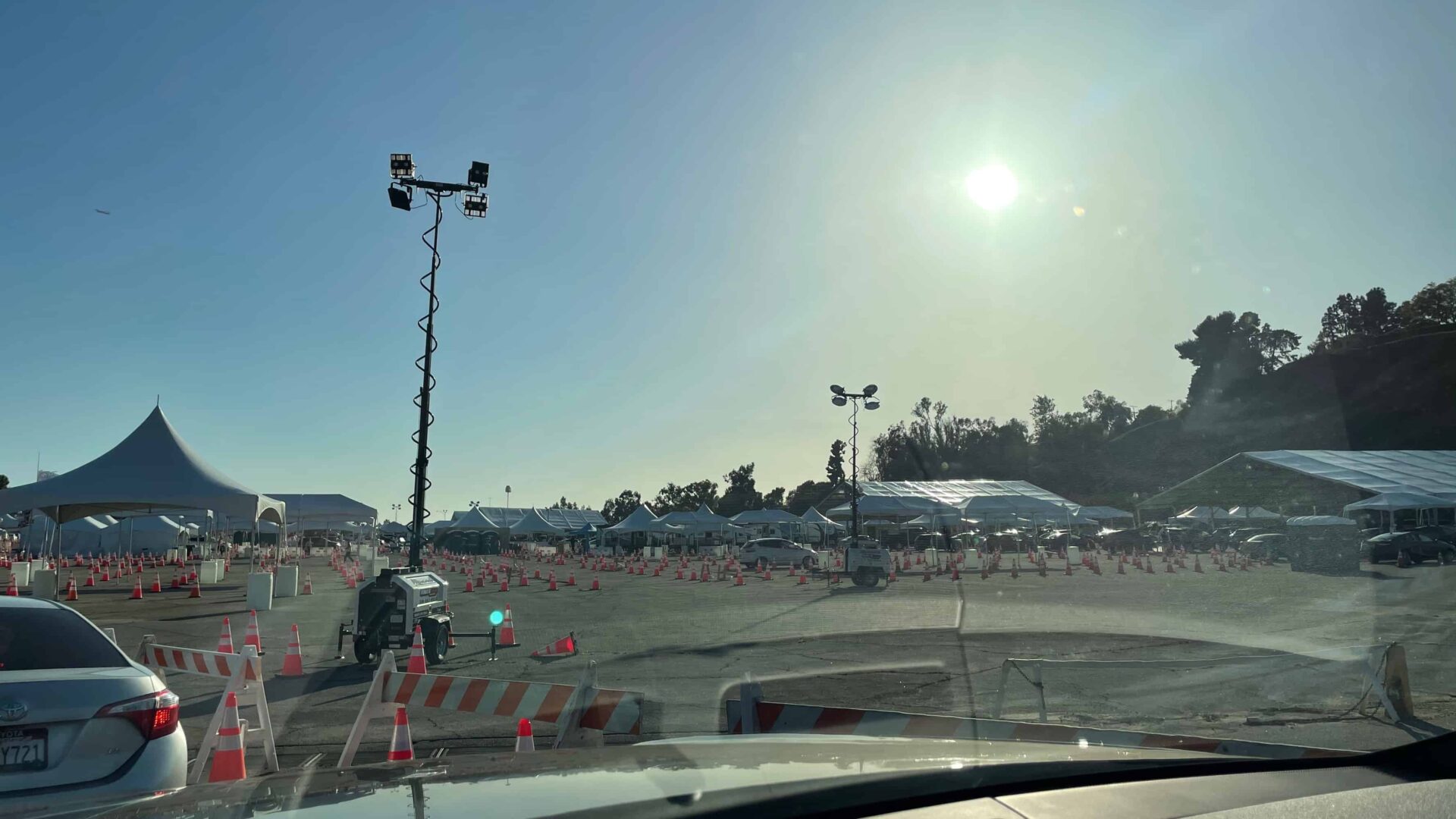
First, here's a photo of Dodger Stadium that I took while waiting briefly to be directed to a lane:
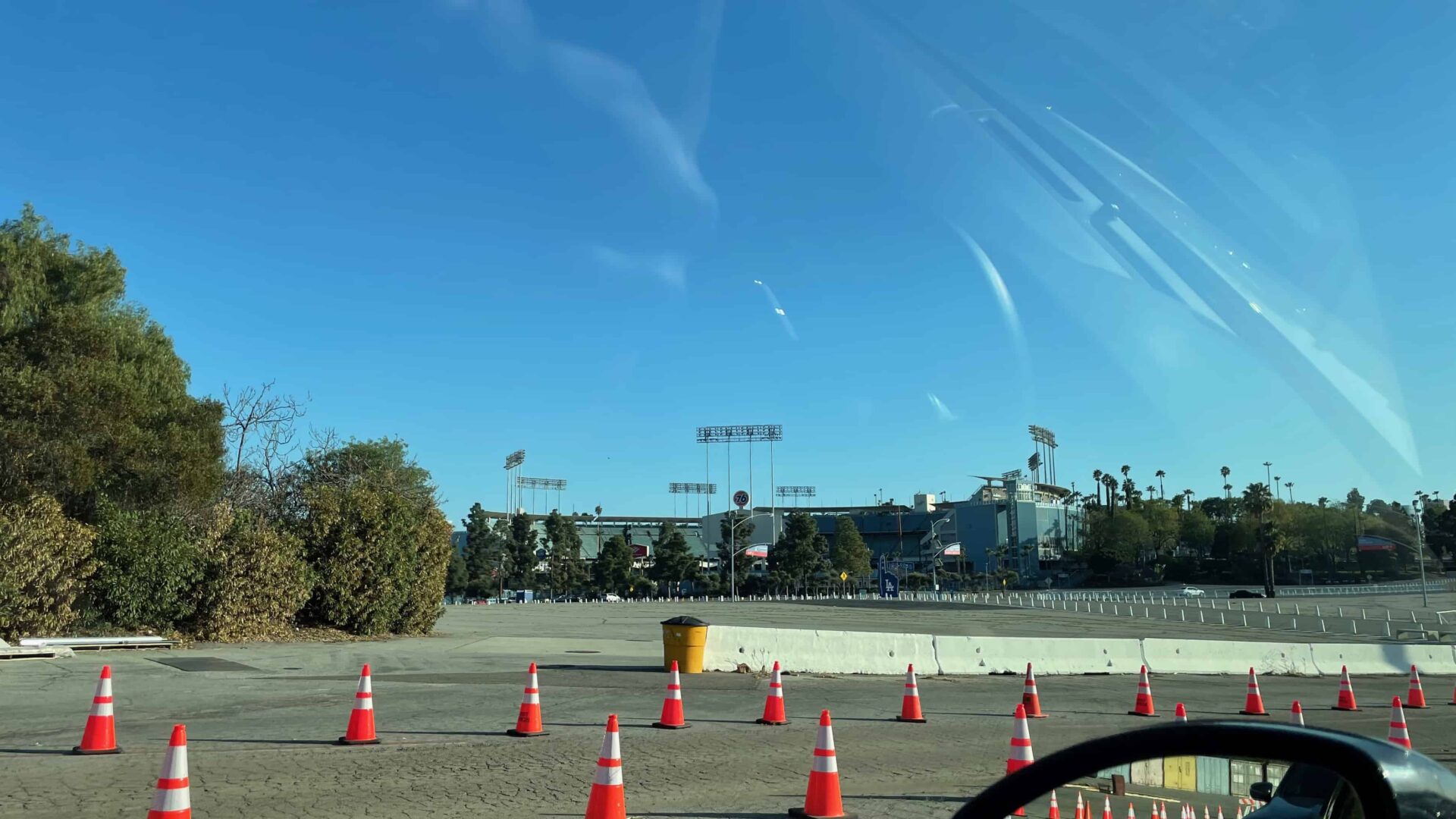
Variation in the Process: The San Diego site had 12 (or as many as 14) cars per batch lane. I heard about a different mass vax site that would do batches of 3 cars per lane.
Being pulled in behind other cars means that you're all basically stuck there until all cars are done with their vaccination and their observation time.
Variation in the Process: Dodger Stadium was basically a “one-step” process, where the San Diego drive-thru site, it was a “two-step” process where cars first went through a registration lane. The patient was asked screening questions, including about allergies. Those who had to wait for 30-minute observation were sent to a specific area for their vaccination and waiting.
Here is a short video about a drive-thru vax site in Denton County, Texas where they describe it as a “four-step” process (and that looks like four separate “stops.” They're doing 30,000 vaccines per week there, it says.
Variation in the Process: In San Diego, was that people who had to wait for 30-minute observation were sent to a different lane where they all pulled head-in into parking lot spaces. The cars weren't in a single-file queue. The advantage of this system is that each car could pull out and leave whenever their individual observation time was done. It wasn't a batch system where the first person vaccinated had to wait until everybody's observation period was done.
Opportunity for Improvement: Test that “pull into parking spots” model to see the impact on flow… but also considering walking distance for staff and the possibly safety (or collision) risk of having more cars moving in more directions.
Here's a photo I took after I pulled into my lane:
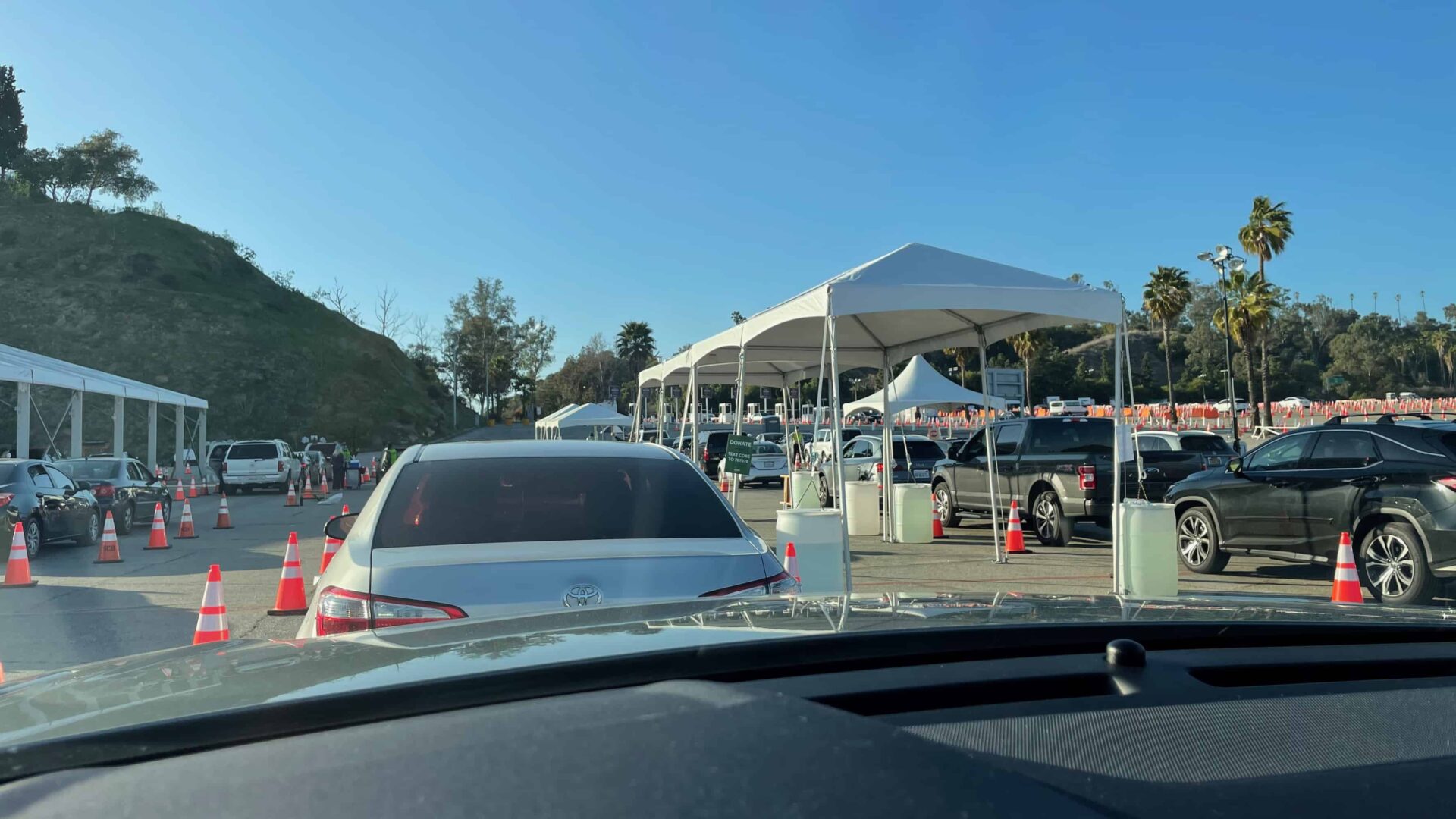
OK, back to my vaccination. When we stopped at the back end of this lane of 10 cars, I put it in park and rolled down the window. It was really unclear what was supposed to happen next. There was a bit of confusion as there were staff talking to each other. Apparently, the normal team for our lane had gone on break (it was about 30 minutes before closing time) and we had a replacement team. They were talking amongst themselves about what they were doing next, what should they do with the extra syringe that was in their cooler, when were the next syringes being delivered?
Opportunity for Improvement: It would have been nice if somebody came to the car to welcome us, confirm that they were giving the J&J vaccine, that there would be a short delay, etc. It might not have been possible for everybody to overhear the conversation about the delay.
Now, since they were toward the end of the day, I totally understand the reasons for very tightly managing the supply of vaccine syringes that are ready to inject. During the start of the day, there can be a steady flow of syringes based on the planned use each hour. But, since you don't want to have leftover doses that might go unused at the end of the day, I can see why they would have more of a direct pull system at this point… don't make the syringe until you know there is an arm for it.
The delay didn't bother me, but the communication about it could have been better.
Variation in the Process / Opportunity for Improvement: In San Diego, they asked everybody to turn off their car in the name of safety. There's a risk that somebody left their car in D and you don't want staff possibly getting trapped between cars. Plus, we can avoid the extra emissions. In our recent podcast, Nate Hurle talked about all of the safety measures that Cleveland Clinic took when they were doing drive-thru Covid testing.
Without the shade, I remember some people in San Diego being uncomfortable with the afternoon sun hitting them, even though it was only 60 degrees or so. I was allowed to keep my A/C running, although I remember having my window down most of the time, as the L.A. weather was nice.
Waiting
I sat there waiting for 23 minutes before somebody came to register me. In fact, the break was over and that “relief crew” left without doing anything, since they were waiting on the syringes.
I was asked for my appointment confirmation again and they took my proof of working in healthcare (a letter from the firm Value Capture). I was asked about any history of reaction to vaccines, did I have any symptoms, did I have Covid recently, etc.
They were still waiting on the vaccines, so there was a 7-minute gap before they came back (with an iPad in hand) to finish my registration.
After that, a small plastic cooler full of syringes was delivered to the lane. I believe the J&J vaccine doesn't have to be kept cold (and what I've seen of vaccination operations with the Pfizer vaccine, that didn't require cold or even cool storage of the syringes — unlike the vials). Maybe coolers was just what they had. They do have handles, which is nice. The syringes could have been in plastic boxes or on trays, as I've seen at other sites (more process variation, I guess.
Ready for Injection
Once the syringes were delivered, I was being approached with a syringe just three minutes later.
As the woman (I think she was a nurse) approached me, she asked which arm. I said, “Left” (which was my preference and I figured it's easier with me being on the driver's side). She asked me to open the door, which probably made it easier for her. Had I wanted my right arm, I definitely would have had to open the door to turn and present that arm.
I think it's great to ask the patient what their preference is, especially if there's risk of arm soreness (my arm never got sore afterward). To me, the Lean principle of “customer focus” (asking which arm and customizing the work to them) is more important than any operational efficiency that would come from always injecting into the driver's left arm and always into the passenger's right arm.
Opportunity for Improvement: I had to ask, “Wait, which vaccine are you giving me?” I would have accepted any of them, but I think this should have been clarified without me asking. I'm pretty sure they did confirm that I was there for a first-dose. You'd want to avoid any risk that I thought I was, for example, getting a 2nd dose Moderna shot, when they were giving first-dose J&J.
The injection was quick and painless. The vaccinator flipped close the safety cap over the needle by bumping it against the door frame, a practice that's intended to reduce the risk of needle sticks.
The needle and cap looked something like this, if you're not familiar with that type of safety cap:
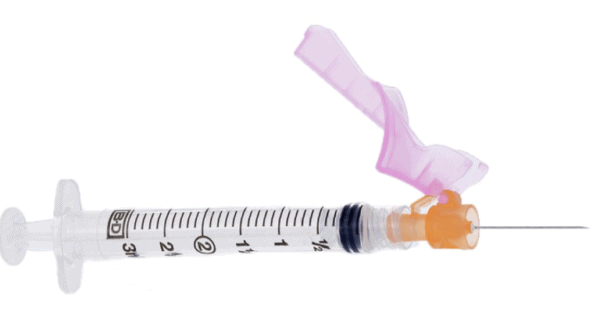
Variation in the Process: I've seen sites that were using “regular” caps some of the time, because they were sent a mix of supplies.
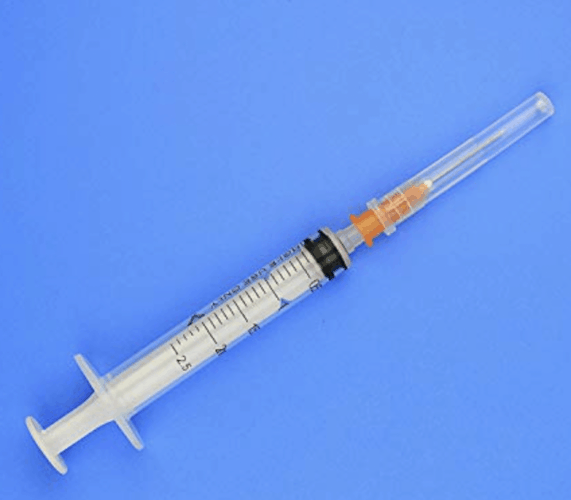
Risk of needle sticks is probably the biggest safety risk to the vaccinators (other than the moving vehicle risk).
Opportunity for Improvement: Always provide safety caps to the vaccinators, so they are kept safe from a possible needle stick and possible deadly infection.
Observation Time
I think I was told that I'd have to wait for 15 minutes for an observation period. If a patient is nervous about the vaccine, communication and reassurance would help.
Opportunity for Improvement: Have standard scripting and/or a hand out (with different languages) for the person who has just been injected. What do you do if you feel poorly?
I did ask, “Am I probably OK to drive or should I have my wife drive me home?” They said I should be OK to drive.
Now, knowing that there are likely some 30-minute observation people in the car queue, I wondered if my total observation time might end up being “how ever long it takes to vaccinate all 10 cars + the longest observation time for any of those 10.” I didn't get a good count of how many vaccinators were working with the 10 cars. It certainly wasn't a 1:1: ratio.
Again, I was fine with the wait. I was happy to have my vaccination.
A few times, somebody came and asked if I was feeling OK. I was.
Leaving
I was surprised that, after about 17 minutes, somebody came over and said I could leave. “How?” I wondered. There were nine cars in front of me still. The person moved some cones so I could pull out to the right and drive immediately to the exit. That was nice of them!
We weren't in the far right lane, but the lanes to the right had emptied out. And, no cars were coming in at this point, so I think it was an easy adjustment to let me out. During the middle of the day, I would have been there longer.
My total time on site was almost exactly one hour. Thanks again to my wife for being the time keeper and note taker.
Variation / Opportunity for Improvement: I was surprised that I wasn't given an information sheet about what to expect in terms of side effects, who to contact if I had bad side effects, etc. I know other sites give out information like this (paper or through the scanning of a QR Code). Not everybody is good with QR codes, by the way…
Oh, before we left, here I am with my vaccination record card (pro tip: don't share your personal information online… that's why I've cropped the photo where I did).
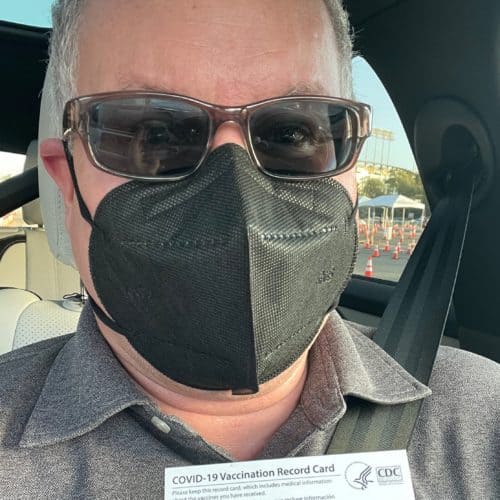
Oh, and we did ask (especially since the staff had been talking about an “extra” syringe), if they had any leftover doses for my wife… they did not. So it goes.
Side Effects
Again, my arm never got sore. The next morning, I woke up feeling normal. But, at about 10 am, I felt flu-like symptoms coming on… just feeling a bit “cruddy.”
I ran a 100F fever for about six hours. It was a Sunday, so I rested, napped… and felt fine by dinner time. I'll take that over the risks of a coronavirus infection and a case of Covid, for sure.
Gratitude
Again, I'm really grateful that I was able to get vaccinated. When I point out “opportunities for improvement,” it's meant to be in a positive spirit. Any small issues or opportunities were clearly systemic problems, not anything that I'm faulting individuals for.
What was your vaccination experience like? Feel free to post a comment and share what you saw, what went well, and what could have been better…
VacciNexus
If you enjoyed reading this… and you are involved in vaccination process design and/or process improvement, we'd love to have you participate in the free “VacciNexus” platform.
KaiNexus is happy to partner with Value Capture to bring you a free online platform for sharing and learning. Built using KaiNexus technology, this site will allow you to easily:
- Share your Covid vaccination process improvements
- Read and learn from improvements shared by other organizations
For more information, check out VacciNexus FAQs here.
What do you think? Please scroll down (or click) to post a comment. Or please share the post with your thoughts on LinkedIn – and follow me or connect with me there.
Did you like this post? Make sure you don't miss a post or podcast — Subscribe to get notified about posts via email daily or weekly.
Check out my latest book, The Mistakes That Make Us: Cultivating a Culture of Learning and Innovation:









